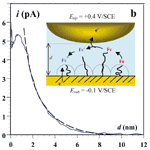Publication
608
J. Phys. Chem. B , 110,, 22664 -22675, 2006 .
DOI:
10.1021/jp064559i
|
|
|
|
|
|
 |
|
Accessing the Dynamics of End-Grafted Flexible Polymer Chains by Atomic Force-Electrochemical Microscopy. Theoretical Modeling of the Approach Curves by the Elastic Bounded Diffusion Model and Monte Carlo Simulations. Evidence for Compression-Induced Lateral Chain Escape |
|
|
|
|
|
|
|
|
|
|
|
Jeremy Abbou, Agnès Anne, and Christophe Demaille
Contribution from the Laboratoire d'Electrochimie Moléculaire, Université de Paris 7-Denis Diderot, 2 place Jussieu,75251 Paris Cedex 05, France
The dynamics of a molecular layer of linear poly(ethylene glycol) (PEG) chains of molecular weight 3400,
bearing at one end a ferrocene (Fc) label and thiol end-grafted at a low surface coverage onto a gold substrate,
is probed using combined atomic force-electrochemical microscopy (AFM-SECM), at the scale of ~100
molecules. Force and current approach curves are simultaneously recorded as a force-sensing microelectrode
(tip) is inserted within the ~10 nm thick, redox labeled, PEG chain layer. Whereas the force approach curve
gives access to the structure of the compressed PEG layer, the tip-current, resulting from tip-to-substrate
redox cycling of the Fc head of the chain, is controlled by chain dynamics. The elastic bounded diffusion
model, which considers the motion of the Fc head as diffusion in a conformational field, complemented by
Monte Carlo (MC) simulations, from which the chain conformation can be derived for any degree of
confinement, allows the theoretical tip-current approach curve to be calculated. The experimental current
approach curve can then be very satisfyingly reproduced by theory, down to a tip-substrate separation of ~2
nm, using only one adjustable parameter characterizing the chain dynamics: the effective diffusion coefficient
of the chain head. At closer tip-substrate separations, an unpredicted peak is observed in the experimental
current approach curve, which is shown to find its origin in a compression-induced escape of the chain from
within the narrowing tip-substrate gap. MC simulations provide quantitative support for lateral chain elongation as the escape mechanism. |

